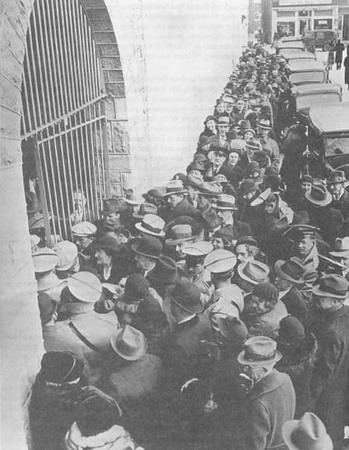Bruno Richard Hauptmann Trial: 1935
Everything Matches
Not only would the state of New Jersey prove that Hauptmann received the money, promised the cigar-smoking 38-year-old Attorney General David T. Wilentz, it would also prove that Hauptmann had kidnapped and murdered the baby and written the ransom notes. Wilentz presented 40 examples of Hauptmann's handwriting and 15 ransom notes that Lindbergh had received. Colonel H. Norman Schwarzkopf, head of the New Jersey State Police (and father of the U.S. Army commanding general in the 1991 Persian Gulf war), testified that Hauptmann had willingly provided handwriting specimens and that the idiosyncratic or Germanic spellings that were found on he specimens and ransom notes were Hauptmann's own and not dictated by the police.
 Crowds lined the streets trying to witness the trial of Bruno Richard Hauptmann.
Crowds lined the streets trying to witness the trial of Bruno Richard Hauptmann.
Next, eight different handwriting experts took the stand. Two had testified in more than 50 trials. Another had helped send Al Capone to prison. A third had been a key witness in a suit over the legitimacy of Rudolf Valentino's will. Using blowups, the experts pointed out similarities between words and letters in the ransom notes and in Hauptmann's writing specimens. By the end of their five days of testimony, Wilentz was rejoicing in a triumph of scientific investigation of evidence.
Even more damning than the handwriting evidence was the testimony on the ladder found alongside the Lindbergh driveway. Arthur Koehler, a wood technologist of the U.S. Department of Agriculture, told how he had examined the ladder microscopically to determine its North Carolina pine origin. Then he traced the distinctive marks of its machine planing through mills to conclude that it had been processed in South Carolina, sold to a Bronx lumber company, and purchased by Hauptmann in December 1931. But one ladder rail was unlike the others. It contained four nail holes that matched four holes in beams in Hauptmann's attic, and the saw-tooth marks across the rail's end grain perfectly matched marks where one attic floor board was shorter than others. When the ladder rail was positioned in the open space on the beams, nails dropped easily into place through the board and into the beams.
Additional topics
- Bruno Richard Hauptmann Trial: 1935 - The Shoebox On The Shelf
- Bruno Richard Hauptmann Trial: 1935 - The Circus Comes To Town
- Other Free Encyclopedias
Law Library - American Law and Legal InformationNotable Trials and Court Cases - 1918 to 1940Bruno Richard Hauptmann Trial: 1935 - Discovered Through Ransom Money, The Circus Comes To Town, Everything Matches, The Shoebox On The Shelf